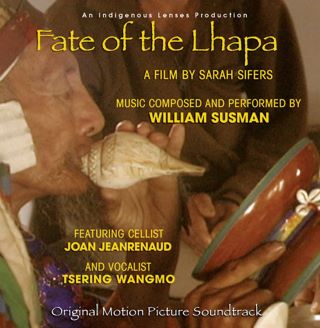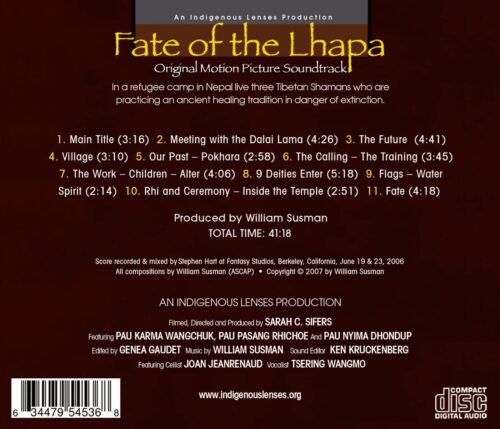IT’S FATE THAT THIS SOUNDTRACK IS AVAILABLE
It amazes me how many films today have a soundtrack that isn’t informed by the movie itself. This interchangeable claptrap has made it almost impossible to review. But composer William Susman flavors the setting of Sarah Sifer’s Fate of the Lhapa beautifully. Interestingly enough, I saw this documentary many, many years ago, and it truly affected me, but I never knew the soundtrack was available until it was sent to me to review 13 years after its original release. Go figure.
While there are certainly traditional forms of Western instrumentation such as harp, Susman has incorporated sounds we would associate with Nepal: There is no list, but I believe we are hearing drums — such as the dhimay, madal, and khin — a bansuri (a bamboo flute), a plucked string (perhaps the tunga), tingsha cymbals, a sringa (a large “C”- or “S”-shaped horn which is also a political symbol), and more. Along the way is minimalism that is so transporting it would make Philip Glass proud, as it helps achieve a sense of bittersweet spirituality so prevalent in the film. (Glass is also a fierce proponent for Nepal’s freedom and Buddhist principles — the latter evidenced in his opera, Satyagraha.)
The movie’s three Lhapas were born in Tibet into a lineage of shamans. At the age of thirteen each experienced a psychotic break and was taken before a Buddhist Lama who determined that each boy’s visionary encounter was the needed marker indicating their fate as a lhapa. The boys embarked on a series of pilgrimages to holy sights under the guidance of a senior lhapa. As China invaded Tibet in the late 1950s the then young men escaped over the Himalayan Mountains and settled in a refugee camp in Nepal.
Fate of the Lhapa occurs in four chapters. Each man’s life as a lhapa has four stages. This corresponds to the four main components of a healing ceremony. Visual images of each ceremony introduces the viewer to the corresponding stage of the men’s lives as lhapas. Fate of the Lhapa also looks at the lhapas lives through three contexts: Their daily life in exile in the Tibetan refugee camp, their roles as seasoned healers, and the possible disappearance of “sucking doctors” in the Tibetan culture.
At their request, they are telling the story of being a Lhapa as if the next heir was sitting at their feet listening to their grandfathers. The refugee camp sits at the base of the Annapurna range of the Himalayan Mountains, in the shadow of Macchapuchre, a mountain considered sacred to both the Tibetan and Nepali people. The beauty of the Nepali countryside and the scope and pageantry of the Tibetan Buddhist traditions that appear throughout the film.
One of the most unearthly instruments used here is the voice of Tsering Wangmo, a Tibetan Buddhist nun who is also a dance and opera singer; she envelops us with a smooth, light but temperate tone that evokes traditional Buddhist chants. She is astoundingly portentous, supernatural, and altogether lovely. Also adding sumptuous touches of resonance is American cellist, who I know as an ex-member of the Kronos Quartet, which she left to pursue a solo career in which she worked with Glass, Steve Reich, Terry Riley and other boundary-pushing artists (her Multiple Sclerosis diagnosis has highly informed her career, which is constantly moving forward into new levels of experimentation).
At first, part of the fun for me was parsing out the instruments (wait — is this sound that conch shell that has both ritual and religious importance in Hinduism?), but magically by the seventh of eleven tracks, they merge into a higher plane of trance-inducing balminess that lovingly elucidates the subject matter. While it’s accurate to say that the music of Susman (who also performs) blends that mysterious, uncanny long-established Asian music with those soul-moving Western strings evokes what the press notes call an “ancient healing tradition in danger of extinction,” this is music that stands alone from the film — in fact, this journey requires you to listen with headphones on and your eyes closed. The mixing by Stephen Hart at Berkeley’s Fantasy Studios makes everything sound crystal clear.
William Susman
Indigenous Lessons
available at Amazon


